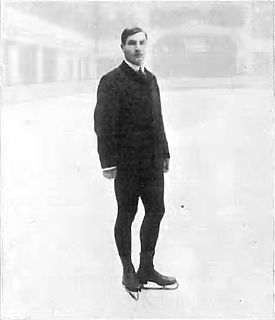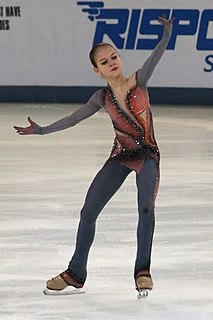
Figure skating is a sport in which individuals, duos, or groups perform on figure skates on ice. It was the first winter sport to be included in the Olympic Games, when it was contested at the 1908 Olympics in London. The four Olympic disciplines are men's singles, ladies' singles, pair skating, and ice dance. Non-Olympic disciplines include synchronized skating, Theater on Ice, and four skating. From intermediate through senior-level competition, skaters generally perform two programs, which may include spins, jumps, moves in the field, lifts, throw jumps, death spirals, and other elements or moves, depending on the discipline.
Figure skating jumps are an element of three competitive figure skating disciplines—men's singles, ladies' singles, and pair skating but not ice dancing. Jumping in figure skating is "relatively recent". They were originally individual compulsory figures, and sometimes special figures; many jumps were named after the skaters who invented them or from the figures from which they were developed. It was not until the early part of the twentieth century, well after the establishment of organized skating competitions, when jumps with the potential of being completed with multiple revolutions were invented and when jumps were formally categorized. In the 1920s, Austrian skaters began to perform the first double jumps in practice. Skaters experimented with jumps, and by the end of the period, the modern repertoire of jumps had been developed. Jumps did not have a major role in free skating programs during international competitions until the 1930s. During the post-war period and into the 1950s and early 1960s, triple jumps became more common for both male and female skaters, and a full repertoire of two-revolution jumps had been fully developed. In the 1980s, men were expected to complete four or five difficult triple jumps, and women had to perform the easier triples. By the 1990s, after compulsory figures were removed from competitions, multi-revolution jumps became more important in figure skating.
Spins are an element in figure skating where the skater rotates, centered on a single point on the ice, while holding one or more body positions. The skater rotates on the part of the blade just behind the toe pick, with the weight on the ball of the foot. There are many types of spins, identified by the position of the arms, legs, and torso, the foot on which the spin is performed, and the entrance to the spin. A combination spin is a spin where the skater would connect a spin with another separate spin. Spins are a required element in most figure skating competitions.

The salchow jump is an edge jump in figure skating. It was named after its inventor, Ulrich Salchow, in 1909. The salchow is accomplished with a takeoff from the back inside edge of one foot and a landing on the back outside edge of the opposite foot. It is "usually the first jump that skaters learn to double, and the first or second to triple". Timing is critical because both the takeoff and landing must be on the backward edge. A salchow is deemed cheated if the skate blade starts to turn forward before the takeoff, or if it has not turned completely backward when the skater lands back on the ice.
The Lutz is a figure skating jump, named after Alois Lutz, an Austrian skater who performed it in 1913. It is a toepick-assisted jump with an entrance from a back outside edge and landing on the back outside edge of the opposite foot. It is the second-most difficult jump and the second-most famous jump after the axel.
The toe loop jump is the simplest jump in the sport of figure skating. It was invented in the 1920s by American professional figure skater Bruce Mapes. The toe loop is accomplished with a forward approach on the inside edge of the blade; the skater then switches to a backward-facing position before his takeoff, which is accomplished from the skater's right back outside edge and left toepick. The jump is exited from the back outside edge of the same foot. It is often added to more difficult jumps during combinations, and is the most common second jump performed in combinations. It is also the most commonly attempted jump.
A layback spin is an upright figure skating spin in which the head and shoulders are dropped backwards and the back arched downwards toward the ice. A common variation has the free leg lifted toward the back, typically in an attitude position, with the arms held above the body, or with a catchfoot position. A common, though very difficult, variation is the Biellmann spin.
The loop jump is an edge jump in the sport of figure skating. It was created by German figure skater Werner Rittberger, and is often called the Rittberger in Europe. It also gets its name from the shape the blade would leave on the ice if the skater performed the rotation without leaving the ice. The skater executes it by taking off from the back outside edge of the skating foot, turning one rotation in the air, and landing on the back outside edge of the same foot. It is often performed as the second jump in a combination.
A spiral is an element in figure skating where the skater glides on one foot while raising the free leg above hip level. It is akin to the arabesque in ballet.

Pair skating is a figure skating discipline defined by the International Skating Union (ISU) as "the skating of two persons in unison who perform their movements in such harmony with each other as to give the impression of genuine Pair Skating as compared with independent Single Skating". The ISU also states that a pairs team must consist of "one Lady and one Man". Pair skating, along with men's and women's single skating, has been an Olympic discipline since figure skating, the oldest Winter Olympic sport, was introduced at the 1908 Summer Olympics in London. The ISU World Figure Skating Championships introduced pair skating in 1908.
The ISU Judging System, occasionally referred to as the Code of Points (COP) system, is the scoring system currently used to judge the figure skating disciplines of men's and ladies' singles, pair skating, ice dance, and synchronized skating. It was designed and implemented by the International Skating Union (ISU), the ruling body of the sport. This system of scoring is used in all international competitions sanctioned by the ISU, including the Olympic Games. The ISU Judging System replaced the previous 6.0 system in 2004. This new system was created in response to the 2002 Winter Olympics figure skating scandal, in an attempt to make the scoring system more objective and less vulnerable to abuse.
The following is a glossary of figure skating terms, sorted alphabetically.

Single skating is a discipline of figure skating in which male and female skaters compete individually. Men's singles and women's singles, along with the other figure skating disciplines of pair skating, ice dance, and synchronized skating, are governed by the International Skating Union (ISU). Figure skating is the oldest winter sport contested at the Olympics, with men's and women's single skating appearing as two of the four figure skating events at the London Games in 1908.

The short program of figure skating is the first of two segments of competitions, skated before the free skating program. It lasts, for both senior and junior singles and pair skaters, 2 minutes and 40 seconds. In synchronized skating, for both juniors and seniors, the short program lasts 2 minutes and 50 seconds. Vocal music with lyrics is allowed for all disciplines since the 2014-2015 season. The short program for single skaters and for pair skaters consists of seven required elements, and there are six required elements for synchronized skaters.

The free skating segment of figure skating, also called the free skate and the long program, is the second of two segments of competitions, skated after the short program. Its duration, across all disciplines, is four minutes for senior skaters and teams, and three-and-one-half minutes for junior skaters and teams. Vocal music with lyrics is allowed for all disciplines since the 2014—2015 season. The free skating program, across all disciplines, must be well-balanced and include certain elements described and published by the International Skating Union (ISU).

Figure skating lifts are a required element in pair skating and ice dancing. Pairs lifts differ from dance lifts most notably in that dancers are not allowed to lift their partners above their shoulders. Lifts are also executed by synchronized skating teams in the free program in competition, as part of a movements in isolation requirement.

A step sequence is an element in figure skating. It is a sequence of steps or moves in the field in a prescribed pattern across the ice. The pattern of the step sequences may be a straight line, circular, or serpentine. In ice dancing, step sequences may be skated either in hold or not touching, with the terms referring to the sequence being performed while in a dance hold or with the dancers not touching each other, respectively.
The axel jump, also called the Axel Paulsen jump for its creator, Norwegian figure skater Axel Paulsen, is an edge jump in the sport of figure skating. It is figure skating's oldest and most difficult jump. It is the only competition jump that begins with a forward takeoff, which makes it the easiest jump to identify. A double or triple axel is required in both the short programs and free skating programs for junior and senior single skaters in all International Skating Union (ISU) competitions. According to The New York Times, the triple axel "has become more common for male skaters" to perform, although the quadruple axel has not yet been successfully completed in competition. As of 2019, 11 women have successfully completed the triple axel in competition. The axel has an extra half rotation, which, as figure skating expert Hannah Robbins states, makes a triple axel "more a quadruple jump than a triple".

Ice dance, a discipline of figure skating, has required elements that make up a well-balanced skating program and must be performed during competitions. They include: the dance lift, the dance spin, the step sequence, twizzles, and choreographic elements. The elements must be performed in specific ways, as described by published communications by the International Skating Union (ISU), unless otherwise specified. Choreographic elements are judged differently; they are considered complete if the minimum requirements defining the element are met.
The 2019–20 Grand Prix of Figure Skating Final and ISU Junior Grand Prix Final was held from December 5–8 at the Torino Palavela in Turin, Italy. The combined event was the culmination of two international series — the Grand Prix of Figure Skating and the Junior Grand Prix. Medals were awarded in the disciplines of men's singles, ladies' singles, pair skating, and ice dance on the senior and junior levels.










